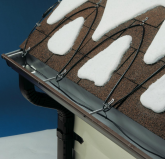Red Squirrel
New Member
- Joined
- Jan 1, 2020
- Messages
- 110
For dust couldn't one use compressed air to blow it off? Brush would work too, except it might scratch panels over time, but think compressed air or even leaf blower with long ABS pipe could work. At least it does not stick like the wet snow or freezing rain does.
Thought of that too just need it to not look obnoxious in case someone complains. My city always sides on complainers when it comes to "eye sores". But yeah I could probably use plywood and paint it or something. Will need to look into it this summer when I redesign the mount to allow a tilt. I could get fancy and make the tilt movable, or just make it static. Static is probably going to be easier to make sure it's strong.
Could you place some rigid sheeting on the sides and back at an angle to act as a wind deflector? So rather than the wind getting under the back of the panel, it's directed up and over? Kinda like a wind deflector on the front of a van or lorry?
Could be made out of plywood or some thin metal sheeting?
Thought of that too just need it to not look obnoxious in case someone complains. My city always sides on complainers when it comes to "eye sores". But yeah I could probably use plywood and paint it or something. Will need to look into it this summer when I redesign the mount to allow a tilt. I could get fancy and make the tilt movable, or just make it static. Static is probably going to be easier to make sure it's strong.






